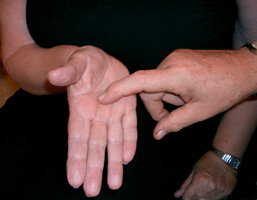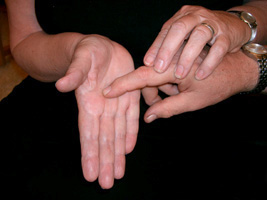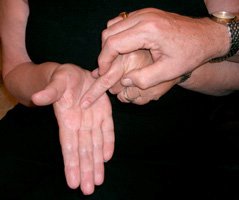Effective techniques for deaf-blind people to communicate with the public
Expressive (deaf-blind person communicates):
- gestures
- voice / recording
- writing (notes / cards / communication devices
- Symbols / pictures / map
- tap the person to alert that they're ready to help (DON'T use tapping as a cue to get off the bus or cross the street!)
- write or spell (print on palm [see below for suggestions], writing on paper with pen or marker, typing into a communication device with braille/print output; etc.)
- speak (if deaf-blind person can understand speech, perhaps with augmentative device)
- yes-no signal (shake head; tap once for "yes" twice for "no", 3 times for "I don't know;" etc.)
- action (point, guide, bring merchandise, etc.)
- structured response / forced-choice (limiting possible responses in order to be quick or understandable). Examples that were developed for specific needs are:
- Te make it easy for the bus driver to respond, a deaf-blind person drew a map and brought it to the driver with a note saying, "Please point to the but stop where I can get off nearest to Fifth and Main streets"
- A deaf-blind person needed to communicate with the station manager through a slot in a window to find out which track the train was on. He pushed a card through the slot; the card had a row of numbers across the top as well as a space saying "No track yet" and a paper clip clipped over "No track yet." Below the row of numbers, the card said, "Please move the paper clip to the track number of the next departing train and return the card. Thank you. I am deaf and blind."
- A deaf-blind person asked a salesperson for an item and was confused when the salesperson wrote a long message explaining they didn't have the item on hand but expected to get it when the truck arrives Thursday.
He spent about half an hour looking around the store for the item and finally left.
The next time, to make the salesperson's response simple enough for him to understand, he gave them a note saying:
- I want to buy a ____________ [the blank is filled in with the desired item]. Please check below:
- ____ We don't carry that item.
____ We carry that item but are out of stock, we expect to have it by __________.
____ We have that item, I will get it for you.
Suggestions for using Print on Palm ("POP"):
- The traditonal way to print letters on someone's palm is to form the letters (all capital letters except for "i") with your finger on their palm, as shown in the first picture below.
- Whenever deaf-blind people have difficulty feeling the shapes, they can put their hand on top of the writer's hand (as shown in the second picture below) and feel the movement in addition to feeling the shape on the skin.
- If you're trying to print on someone's palm and they can't perceive it, even when their hand is on yours, you can ask them if you can draw on their palm using their own finger, as shown in the last picture below.



Return to Teaching Deaf-Blind People to Communicate and Interact with the Public
Return to Home page